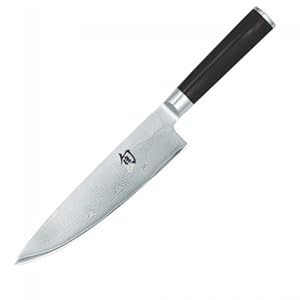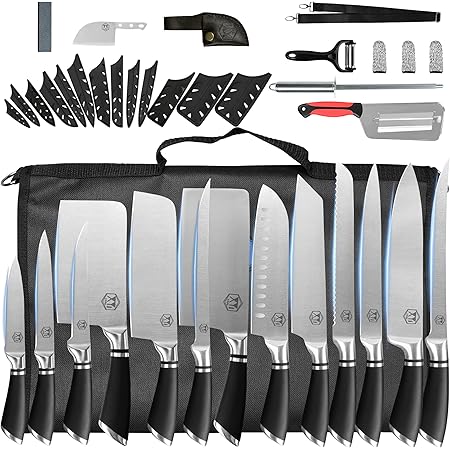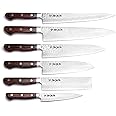Choosing the right chef’s knife can feel like navigating a minefield. With countless brands, styles, and materials, it’s easy to get overwhelmed. This guide dives deep into the world of stainless steel chef knives, specifically comparing the popular Japanese and Western styles to help you find the perfect blade for your kitchen.
The Core Differences: Japanese vs. Western Blade Design

The most significant distinction lies in the blade’s geometry and construction. Western knives, typically German or French in origin, tend to have a thicker blade with a full bolster (the metal piece connecting the blade to the handle). This bolster provides balance and protection for the hand, but it also increases weight. The blade profile is often more robust, designed for forceful chopping and slicing through tougher ingredients. The edge geometry is usually a flatter bevel, which is easier to sharpen for less experienced users.
Japanese knives, on the other hand, are renowned for their elegance and precision. They are often thinner, lighter, and more delicate than their Western counterparts. Many feature a thinner blade profile and a single bevel (although double-bevel Japanese knives are becoming increasingly common), leading to exceptional sharpness. The lack of a bolster on many models allows for a more delicate touch and better control during intricate work like slicing fish or vegetables. The thinner profile requires a gentler approach and more regular sharpening.
Steel Composition: The Heart of the Blade
Both Japanese and Western knives utilize stainless steel, but the specific alloys and their composition can significantly impact performance. Western stainless steel often prioritizes durability and stain resistance, sometimes at the expense of edge sharpness and refinement. Japanese stainless steel often incorporates higher percentages of harder elements, resulting in a blade that holds its edge exceptionally well but may require more careful handling to prevent chipping.
You’ll often see terms like “high-carbon stainless steel” associated with both types of knives. Higher carbon content generally translates to a harder, sharper, and more durable edge. However, high-carbon steel can be more brittle, so finding the right balance is crucial. The specific alloy used – often proprietary blends – will influence factors like corrosion resistance, edge retention, and the overall ease of sharpening.
Sharpening and Maintenance: A Key Consideration
Because of their thinner profiles and often harder steel, Japanese knives generally require more frequent sharpening than Western knives. While this might seem like a drawback, many cooks appreciate the incredibly sharp edge that a properly honed Japanese knife provides. The ability to achieve a razor-sharp edge is why many professionals favor Japanese knives. However, this means investing in a good honing steel and learning proper sharpening techniques is essential.
Western knives, with their thicker blades, are often more forgiving in terms of sharpening. They can withstand more abuse before needing sharpening, and they tend to be easier to sharpen for home cooks. However, the edge may not reach the same level of extreme sharpness as a well-maintained Japanese knife.
Handle Design and Ergonomics

The handle design is another area where differences emerge. Western knives typically feature full tang or bolster construction, contributing to balance and durability. Japanese knives may have a full tang, but many feature a less robust handle construction, favoring lighter weight and a more agile feel in the hand. The handle material varies greatly in both styles, with options ranging from wood, resin, and synthetic materials. Choosing a handle that feels comfortable and provides a secure grip is essential, regardless of the knife’s origin.
The Importance of “Torque” (in relation to knife performance)

While “torque” isn’t a direct specification for knives like it is for engines, the concept is applicable. The *effective torque* of a knife refers to the ability to efficiently transfer force from your hand to the cutting edge. A well-balanced knife, regardless of style, will deliver better torque. A heavy knife with a long blade might feel powerful, but its weight can hinder precision and control. Conversely, a lightweight knife with a poorly designed handle will struggle to deliver effective cutting force. Finding a balance is key to achieving optimal “torque” and effortless cutting.
Which Knife is Right for You?

Ultimately, the best chef’s knife depends on your individual needs and preferences. Western knives are excellent for cooks who prioritize durability, ease of sharpening, and a more robust feel. They are well-suited for tackling tougher ingredients and those less experienced with knife sharpening. Japanese knives, while requiring more maintenance, offer exceptional sharpness and precision, ideal for cooks who value fine control and are willing to invest time in sharpening.
Consider your cooking style: Do you primarily prepare meat? Fish? Vegetables? A heavier Western knife might be more suitable for butchering meats, while a lighter Japanese knife excels in delicate vegetable work. Experimenting with different knives can help you determine what feels most comfortable and efficient in your hands.
Don’t hesitate to visit a well-stocked kitchen supply store and handle different knives before making a purchase. Feeling the weight, balance, and the overall feel of the knife in your hand is critical. Reading reviews and watching videos demonstrating different knives in action can also be helpful in narrowing your search.
Choosing the right chef’s knife is a personal journey. With careful consideration of the factors outlined above, you can find a blade that elevates your culinary experience for years to come.